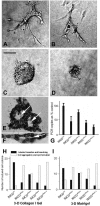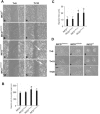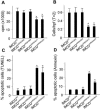Inhibition of Pkhd1 impairs tubulomorphogenesis of cultured IMCD cells
- PMID: 15975909
- PMCID: PMC1196347
- DOI: 10.1091/mbc.e04-11-1019
Inhibition of Pkhd1 impairs tubulomorphogenesis of cultured IMCD cells
Abstract
Fibrocystin/polyductin (FPC), the gene product of PKHD1, is responsible for autosomal recessive polycystic kidney disease (ARPKD). This disease is characterized by symmetrically large kidneys with ectasia of collecting ducts. In the kidney, FPC predominantly localizes to the apical domain of tubule cells, where it associates with the basal bodies/primary cilia; however, the functional role of this protein is still unknown. In this study, we established stable IMCD (mouse inner medullary collecting duct) cell lines, in which FPC was silenced by short hairpin RNA inhibition (shRNA). We showed that inhibition of FPC disrupted tubulomorphogenesis of IMCD cells grown in three-dimensional cultures. Pkhd1-silenced cells developed abnormalities in cell-cell contact, actin cytoskeleton organization, cell-ECM interactions, cell proliferation, and apoptosis, which may be mediated by dysregulation of extracellular-regulated kinase (ERK) and focal adhesion kinase (FAK) signaling. These alterations in cell function in vitro may explain the characteristics of ARPKD phenotypes in vivo.
Figures









Similar articles
-
Cystogenesis in ARPKD results from increased apoptosis in collecting duct epithelial cells of Pkhd1 mutant kidneys.Exp Cell Res. 2011 Jan 15;317(2):173-87. doi: 10.1016/j.yexcr.2010.09.012. Epub 2010 Sep 25. Exp Cell Res. 2011. PMID: 20875407
-
Abnormalities in focal adhesion complex formation, regulation, and function in human autosomal recessive polycystic kidney disease epithelial cells.Am J Physiol Cell Physiol. 2010 Apr;298(4):C831-46. doi: 10.1152/ajpcell.00032.2009. Epub 2009 Nov 18. Am J Physiol Cell Physiol. 2010. PMID: 19923420 Free PMC article.
-
Loss of Bicc1 impairs tubulomorphogenesis of cultured IMCD cells by disrupting E-cadherin-based cell-cell adhesion.Eur J Cell Biol. 2010 Jun;89(6):428-36. doi: 10.1016/j.ejcb.2010.01.002. Epub 2010 Mar 9. Eur J Cell Biol. 2010. PMID: 20219263 Free PMC article.
-
Molecular basis of autosomal recessive polycystic kidney disease (ARPKD).Adv Anat Pathol. 2008 Jan;15(1):54-8. doi: 10.1097/PAP.0b013e31815e5295. Adv Anat Pathol. 2008. PMID: 18156813 Review.
-
[From gene to disease; PKHD1 and recessive polycystic kidney disease].Ned Tijdschr Geneeskd. 2005 Feb 26;149(9):463-6. Ned Tijdschr Geneeskd. 2005. PMID: 15771341 Review. Dutch.
Cited by
-
ErbB4 isoforms selectively regulate growth factor induced Madin-Darby canine kidney cell tubulogenesis.Mol Biol Cell. 2007 Nov;18(11):4446-56. doi: 10.1091/mbc.e07-03-0223. Epub 2007 Aug 29. Mol Biol Cell. 2007. PMID: 17761534 Free PMC article.
-
Development of the post-natal growth plate requires intraflagellar transport proteins.Dev Biol. 2007 May 1;305(1):202-16. doi: 10.1016/j.ydbio.2007.02.003. Epub 2007 Feb 12. Dev Biol. 2007. PMID: 17359961 Free PMC article.
-
Rab35 controls cilium length, function and membrane composition.EMBO Rep. 2019 Oct 4;20(10):e47625. doi: 10.15252/embr.201847625. Epub 2019 Aug 21. EMBO Rep. 2019. PMID: 31432619 Free PMC article.
-
Conditional mutation of Pkd2 causes cystogenesis and upregulates beta-catenin.J Am Soc Nephrol. 2009 Dec;20(12):2556-69. doi: 10.1681/ASN.2009030271. Epub 2009 Nov 25. J Am Soc Nephrol. 2009. PMID: 19939939 Free PMC article.
-
c-Src inactivation reduces renal epithelial cell-matrix adhesion, proliferation, and cyst formation.Am J Physiol Cell Physiol. 2011 Aug;301(2):C522-9. doi: 10.1152/ajpcell.00163.2010. Epub 2011 Apr 20. Am J Physiol Cell Physiol. 2011. PMID: 21508333 Free PMC article.
References
-
- Ambros, V. (2004). The functions of animal microRNAs. Nature 431, 350-355. - PubMed
-
- An, J., Chen, Y., Huang, Z. (2004). Critical upstream signals of cytochrome C release induced by a novel bcl-2 inhibitor. J. Biol. Chem. 279, 19133-19140. - PubMed
-
- Balda, M. S., and Matter, K. (2003). Epithelial cell adhesion and the regulation of gene expression. Trends Cell Biol. 13, 310-318. - PubMed
-
- Berridge, M. V., Tan, A. S., McCoy, K. D., and Wang, R. (1996). The biochemical and cellular basis of cell proliferation assays that use tetrazolium salts. Biochemica 4, 12-20.
-
- Boletta, A., Qian, F., Onuchic, L. F., Bhunia, A. K., Phakdeekitcharoen, B., Hanaoka, K., Guggino, W., Monaco, L., Germino, G. G. (2002). Polycycstin-1, the gene product of PKD1, induces resistance to apoptosis and spontaneous tubulogenesis in MDCK cells. Mol. Cell 6, 1267-1273. - PubMed
Publication types
MeSH terms
Substances
Grants and funding
LinkOut - more resources
Full Text Sources
Molecular Biology Databases
Miscellaneous

